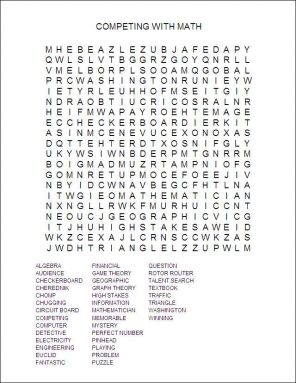Competing with math
Five high schoolers are the new faces of mathematics
Share this:
- Share via email (Opens in new window) Email
- Click to share on Facebook (Opens in new window) Facebook
- Click to share on X (Opens in new window) X
- Click to share on Pinterest (Opens in new window) Pinterest
- Click to share on Reddit (Opens in new window) Reddit
- Share to Google Classroom (Opens in new window) Google Classroom
- Click to print (Opens in new window) Print
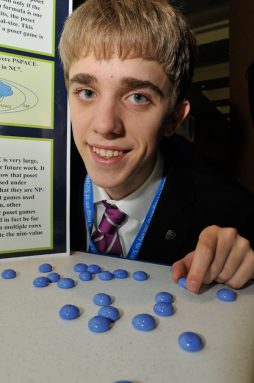
Adam Kalinich, 17, can be forgiven for having a little too much fun at science fairs. After all, this young researcher, who attends the Illinois Mathematics and Science Academy, in Aurora, studies what might seem like an unlikely topic: games.
In March, he attended an open house for the 2012 Intel Science Talent Search, a national science and engineering competition for high school students. While there, he presented an old game called Nim and explained how mathematics can help people find strategies for winning such games — or much more high-stakes ones.
Kalinich stood next to his poster board in the headquarters of the National Geographic Society, in Washington, D.C. Before him on a table were four rows of bright-blue stones. The goal of Nim, he explained, is for two players to take turns removing any number of stones from the rows until none remain. He pulled in one of his cofinalists for a match. After several turns, Kalinich picked up the last blue stone for the win.
But Kalinich doesn’t play Nim just for fun. He uses math to study Nim and other such choice, or poset, games, to investigate how hard would it be for a computer to “solve” one of these games. In other words, he asks the question: How difficult would it be for a computer to run through each and every choice that two poset game players could ever make?
Kalinich says he came closer to answering that question than any other mathematician. And he’s confirmed that it’s not a relatively easy feat.
Kalinich wasn’t the only young mathematician to wow audiences both young and old in Washington. In fact, this year, math was one of the most popular topics at the Intel STS. The competition is sponsored by the Intel Corporation and run by Society for Science & the Public, the publisher of Science News for Kids. Of 40 finalists this year, five — or 1 in every 8 — strutted their math stuff. That’s more than last year.
Kalinich’s work fits into a field of study called game theory, which, among other things, explores what strategies people should take when they compete with others, from playing games to trading financial stocks. It’s an appealing area of study because, well, who doesn’t like a good game?
“If a 4- or 5-year-old kid comes up and asks to see my project … I can show them Nim,” Kalinich says. On some level, “this is really understandable for everyone.”
David Marker, a mathematician at the University of Illinois at Chicago who has judged the competition for 12 years, was impressed with this year’s crop of mathematicians. He says it’s great to see so many students tackling topics — and not just in math — that might normally be regarded as for nerds only. “Science is not always thought of as the cool thing to do, and to see all these students doing high-level work is fantastic,” he says. “It gives hope for the future.”
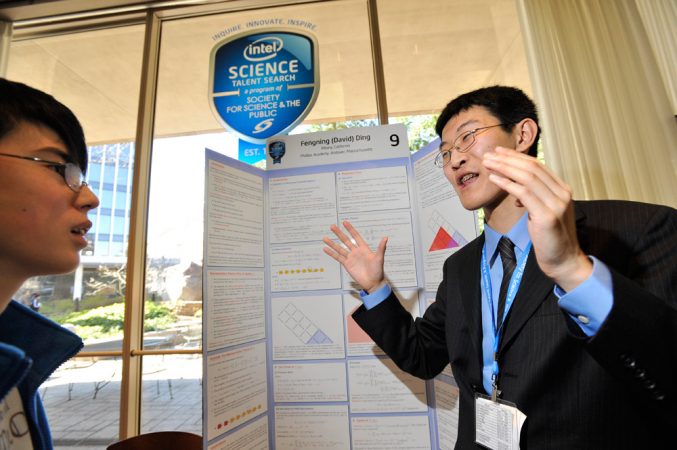
David Ding, who placed fourth in the Intel STS competition, explored a type of math called Cherednik algebras for his project. An 18-year-old at the Phillips Academy in Andover, Mass., he finds that getting to the bottom of a math problem can be challenging and fun.
It took him a little while to figure that out, however. As a child, Ding wanted to be an astronaut. So he studied astronomy, including how the planets rotate around the sun. That turned him on to physics, the science of matter, energy and motion. And this, eventually, led him to math.
While reading physics textbooks, he encountered all types of math concepts. And along the way, he says, “I found out that math is interesting by itself.”
Math, many of the finalists say, can be so exciting simply because it’s a puzzle that needs solving.
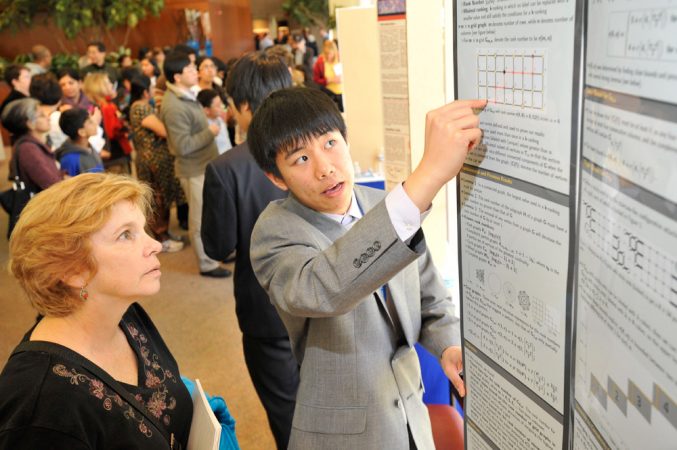
That has been true for Sitan Chen, 17, now a student at Northview High School in Duluth, Ga. His dad started giving him math problems to scratch his way through when he was as young as 5. The most memorable puzzles, he says, were ones in which he had to figure out how long the sides of several triangles were based on some starting information. Over time, Chen discovered that these exercises were a lot like detective work. “In the end, it really showed me the thrill that’s associated with searching for the answer,” he says.
Chen now studies a field of math called graph theory. Essentially, he tries to assemble graphs — similar to the square grids on checkerboards, only with a number at each corner — that follow certain rules. He tries to figure out how simple these graphs can be, or how few numbers mathematicians could use to design a grid that still fits the rules.
Chen’s work may one day give engineers an edge in building tiny circuit boards, electronic chips that might be the size of a pinhead and run devices such as iPod nanos. That’s because graphs like Chen’s resemble how electricity zips down wires and around corners in a circuit. The topic may be much more difficult than those early triangle puzzles his dad gave him, but he says that it holds much the same thrill.
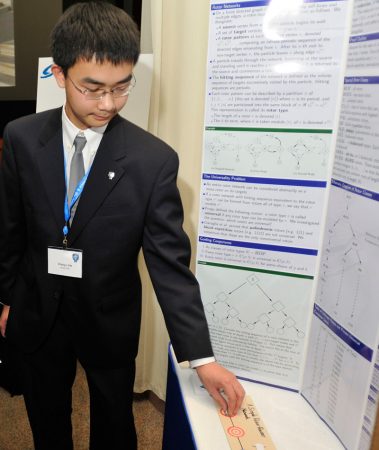
Finalist Xiaoyu He, 18, has dug into another type of puzzle. A student at the Acton-Boxborough Regional High School in Massachusetts, He studies something known as rotor-routers. In a very simple sense, they’re similar to traffic lights. Only these traffic lights essentially provide rules for information — such as the data flowing through a computer. These rules instruct “car loads” of data which way to turn and how far to travel. Such traffic lights can be useful when two or more computers are chugging away together on the same problem. With better information flow, one computer won’t wind up doing too much of the work, He says.
Anirudh Prabhu, 17, says trying to solve a math problem means “you’re part of an ongoing mystery.” His mystery-of-choice has been ongoing for quite a long time.
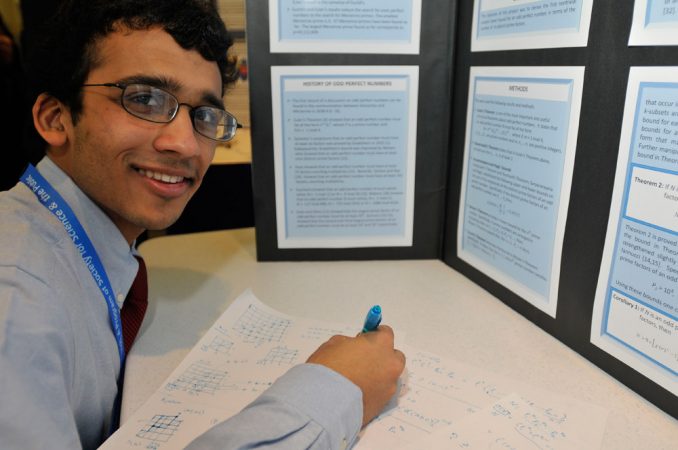
At West Lafayette Junior-Senior High School in Indiana, Prabhu studies a special set of digits called perfect numbers, the smallest of which is 6. A number is “perfect” when all of the whole numbers that can be evenly divided into it — in this case, 1, 2 and 3 — also add up to 6. These numbers have intrigued mathematicians dating back to Euclid, an ancient Greek thinker who lived around 300 B.C.
So far, mathematicians have discovered 47 perfect numbers, including 8,128 and 33,550,336. But strangely, Prabhu says, not one of them is an odd number.
Mathematicians claim that if odd perfect numbers exist, they’re likely huge. In fact, they’d have at least 1,500 zeroes, some say. Prabhu’s now trying to prove that odd perfect numbers don’t exist. To do this, he employed his math skills to narrow down the list of numbers that could possibly be both perfect numbers and odd numbers. Once that list gets small enough, he says, mathematicians will be able to know for sure if such digits are real. Even Euclid would think that was neat.
Marker says he expects big things from all five of this year’s math scholars at Intel STS. Many of the competition’s past finalists have become researchers at top universities, including MIT or Stanford, he notes. Two even won a Fields Medal, one of the top prizes in mathematics. Indeed, the judge notes, “Math [finalists] tend to be very committed.”
For Kalinich that means also making sure the world never runs out of future mathematicians. He recently traveled to Cambodia, where he taught math classes to high school students in the cities Phnom Penh and Siem Reap. Of course, he and his pupils set aside time to play games, too, even staging a tournament to win a game called Chomp, a close cousin of Nim.
“We’re losing countless numbers of [potential mathematicians] because they’re never getting the opportunity to learn,” Kalinich says. “I want to make sure everybody gets that opportunity.” Now, that’s a good starting move.
Word Find (click here to print puzzle)
